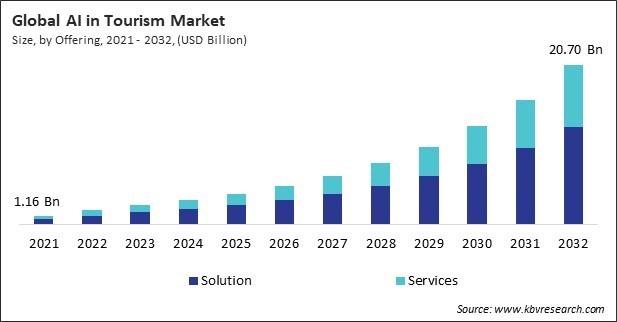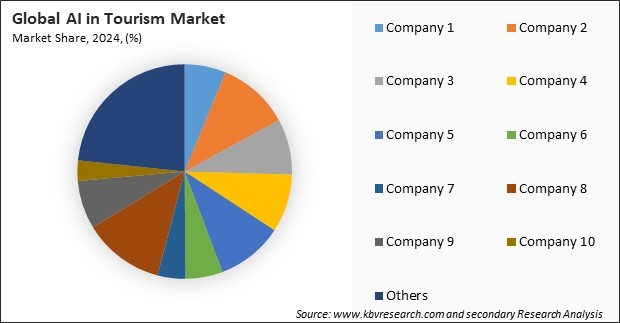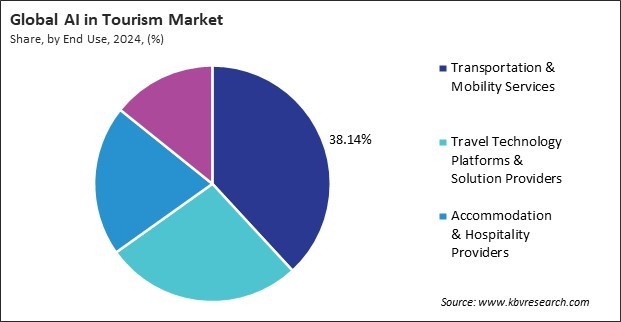“Global AI in Tourism Market to reach a market value of USD 20.70 Billion by 2032 growing at a CAGR of 26.3%”
The Global AI in Tourism Market size is expected to reach $20.70 billion by 2032, rising at a market growth of 26.3% CAGR during the forecast period.
The North America segment recorded 37% revenue share in the market in 2024. This growth can be attributed to the strong presence of advanced technological infrastructure, widespread adoption of AI across industries, and a well-established regional tourism sector. Major players in the travel and hospitality industry across the U.S. and Canada have been actively leveraging AI to enhance customer experience, optimize pricing strategies, and streamline operations.

The increasing desire for personalized travel experiences is one of the primary drivers of the market. Consumers today seek more customized and unique experiences, moving away from standard packages and mass tourism. AI technology is crucial in responding to this demand, enabling tourism companies to offer tailored travel recommendations, accommodations, and itineraries based on individual preferences and historical data. Therefore, the rising demand for personalized travel experiences propels the market's growth.
Additionally, Rising investments in AI research and development (R&D) within the tourism industry drive the rapid adoption of AI technologies across diverse travel and tourism sector segments. With significant funding flowing into AI-driven innovations, there has been a surge in the development of AI-based solutions designed to enhance operational efficiency, optimize customer experiences, and offer predictive insights. Thus, increased investments in AI research and tourism development are propelling the market's growth.
However, One of the significant restraints in AI adoption within the tourism sector is the high initial investment and development costs associated with integrating AI technologies. While AI offers substantial benefits, including operational efficiencies, personalized experiences, and improved customer service, the costs of implementing AI systems can be prohibitive for small and medium-sized businesses. Thus, high initial investment and development costs for AI integration in tourism are hindering market growth.

The leading players in the market are competing with diverse innovative offerings to remain competitive in the market. The above illustration shows the percentage of revenue shared by some of the leading companies in the market. The leading players of the market are adopting various strategies in order to cater demand coming from the different industries. The key developmental strategies in the market are Acquisitions, and Partnerships & Collaborations.
Based on offering, the market is characterized into solution and services. The services segment procured 37% revenue share in the market in 2024. This segment includes consulting, integration, and support services that help organizations implement and optimize AI technologies within their operations. With increasing awareness of AI's benefits, tourism businesses are seeking expert guidance to integrate AI into legacy systems, ensure scalability, and maintain smooth operations.
On the basis of end use, the market is classified into transportation & mobility services, travel technology platforms & solution providers, accommodation & hospitality providers, and tourism experience & attraction operators. The travel technology platforms & solution providers segment recorded 27% revenue share in the market in 2024. This segment includes companies that develop and deliver digital platforms, software solutions, and AI-driven tools that support tourism businesses in managing bookings, customer engagement, data analytics, and personalization. The growing reliance on cloud-based platforms and intelligent software by travel agencies, tour operators, and online travel aggregators has fuelled demand for AI-powered solutions.

Free Valuable Insights: Global AI in Tourism Market size to reach USD 20.70 Billion by 2032
Region-wise, the market is analyzed across North America, Europe, Asia Pacific, and LAMEA. The Europe segment witnessed 29% revenue share in the market in 2024. Countries across the region have been increasingly integrating AI technologies into their tourism services to attract more international visitors and improve service efficiency. Implementing AI-driven tools such as virtual travel assistants, smart recommendations, and multilingual customer support has improved tourist travel experiences.
| Report Attribute | Details |
|---|---|
| Market size value in 2024 | USD 3.22 Billion |
| Market size forecast in 2032 | USD 20.70 Billion |
| Base Year | 2024 |
| Historical Period | 2021 to 2023 |
| Forecast Period | 2025 to 2032 |
| Revenue Growth Rate | CAGR of 26.3% from 2025 to 2032 |
| Number of Pages | 212 |
| Number of Tables | 260 |
| Report coverage | Market Trends, Revenue Estimation and Forecast, Segmentation Analysis, Regional and Country Breakdown, Market Share Analysis, Porter’s 5 Forces Analysis, Company Profiling, Companies Strategic Developments, SWOT Analysis, Winning Imperatives |
| Segments covered | Offering, End Use, Region |
| Country scope |
|
| Companies Included | Huawei Technologies Co., Ltd. (Huawei Investment & Holding Co., Ltd.), IBM Corporation, Amazon Web Services, Inc. (Amazon.com, Inc.), Microsoft Corporation, NVIDIA Corporation, Sabre Corporation, SAS Institute Inc., Snowflake Inc., Salesforce, Inc., and OpenAI, LLC |
By Offering
By End Use
By Geography
Our team of dedicated experts can provide you with attractive expansion opportunities for your business.

 Drivers
Drivers
 Restraints
Restraints
 Opportunities
Opportunities
 Challenges
Challenges
